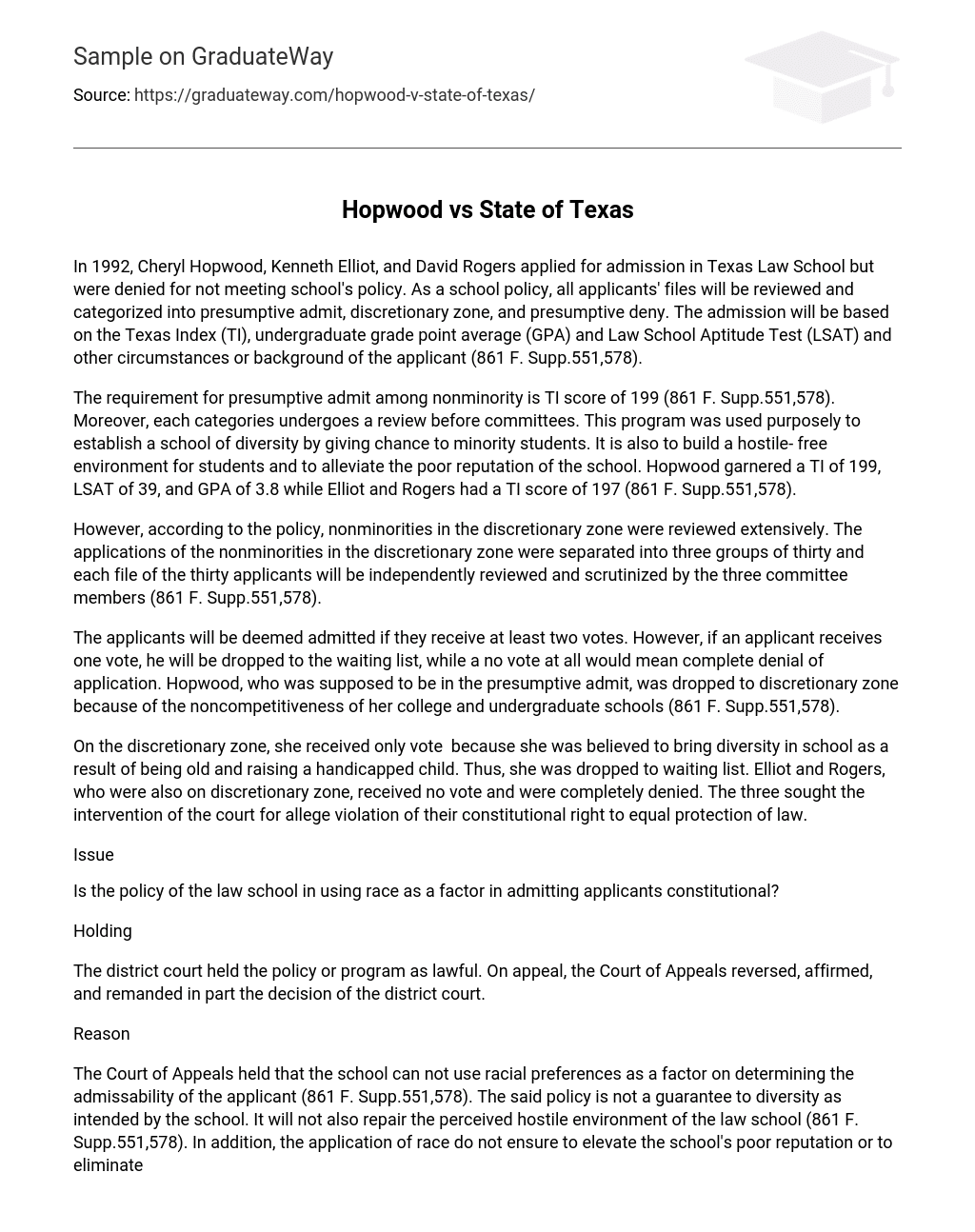In 1992, Cheryl Hopwood, Kenneth Elliot, and David Rogers applied for admission in Texas Law School but were denied for not meeting school’s policy. As a school policy, all applicants’ files will be reviewed and categorized into presumptive admit, discretionary zone, and presumptive deny. The admission will be based on the Texas Index (TI), undergraduate grade point average (GPA) and Law School Aptitude Test (LSAT) and other circumstances or background of the applicant (861 F. Supp.551,578).
The requirement for presumptive admit among nonminority is TI score of 199 (861 F. Supp.551,578). Moreover, each categories undergoes a review before committees. This program was used purposely to establish a school of diversity by giving chance to minority students. It is also to build a hostile- free environment for students and to alleviate the poor reputation of the school. Hopwood garnered a TI of 199, LSAT of 39, and GPA of 3.8 while Elliot and Rogers had a TI score of 197 (861 F. Supp.551,578).
However, according to the policy, nonminorities in the discretionary zone were reviewed extensively. The applications of the nonminorities in the discretionary zone were separated into three groups of thirty and each file of the thirty applicants will be independently reviewed and scrutinized by the three committee members (861 F. Supp.551,578).
The applicants will be deemed admitted if they receive at least two votes. However, if an applicant receives one vote, he will be dropped to the waiting list, while a no vote at all would mean complete denial of application. Hopwood, who was supposed to be in the presumptive admit, was dropped to discretionary zone because of the noncompetitiveness of her college and undergraduate schools (861 F. Supp.551,578).
On the discretionary zone, she received only vote because she was believed to bring diversity in school as a result of being old and raising a handicapped child. Thus, she was dropped to waiting list. Elliot and Rogers, who were also on discretionary zone, received no vote and were completely denied. The three sought the intervention of the court for allege violation of their constitutional right to equal protection of law.
Issue
Is the policy of the law school in using race as a factor in admitting applicants constitutional?
Holding
The district court held the policy or program as lawful. On appeal, the Court of Appeals reversed, affirmed, and remanded in part the decision of the district court.
Reason
The Court of Appeals held that the school can not use racial preferences as a factor on determining the admissability of the applicant (861 F. Supp.551,578). The said policy is not a guarantee to diversity as intended by the school. It will not also repair the perceived hostile environment of the law school (861 F. Supp.551,578). In addition, the application of race do not ensure to elevate the school’s poor reputation or to eliminate present effects of past discrimination of other entities (861 F. Supp.551,578).
In addition, the Court of Appeals held the district court is in error in judging on the principle of repairing the effects of past discrimination. For this, the Court decided that it is not the law school but the University of Texas System that is the appropriate unit to measure the constitutional remedy (861 F. Supp.551,578). Moreover, the defence of the law school that the the policy was a means of repairing the past discrimination was rejected by the court because the racial preferences used in admission do not justify a compelling interest (861 F. Supp.551,578).
It is also a policy that if a school adopts a racial preferences program, like that adopted by Texas law school, it must be scrutinized to ensure that it is not conflicting with the Constitutional provisions.
References
National Association of College and University Attorneys. (2008). Cheryl J. Hopwood, et al. versus State of Texas. Retrieved June 25, 2008, from http://www.nacua.org/documents/hopwoodVsStateofTexas.html





